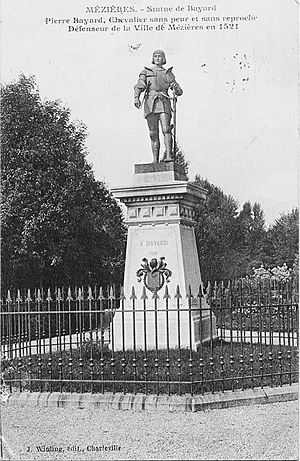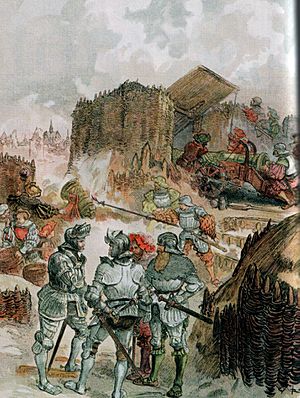Siege of Mézières facts for kids
The siege of Mézières was a big fight that happened in 1521. It was part of a larger conflict called the Italian War of 1521–1526. The town of Mézières, which is now part of Charleville-Mézières in France, was attacked by a huge army from the Holy Roman Empire. French soldiers defended Mézières. They were led by two brave commanders: Pierre Terrail, seigneur de Bayard and Anne de Montmorency.
The attack on Mézières failed. The French soldiers fought very hard and held their ground. This strong defense gave Francis I of France, the French king, more time. He used this time to gather his forces against Charles V, the leader of the Holy Roman Empire.
Why the Siege Happened
Before the siege, France had tried to attack Spanish lands in 1521. This attack didn't go well. A rebellion in the Kingdom of Navarre, which Spain had taken control of in 1512, forced the French to retreat. On June 30, 1521, the French lost a battle called the Battle of Noain. This meant the kings of Castile kept control over Navarre.
There had been a short period of peace after Charles V was elected. During this time, England tried to help France and the Holy Roman Empire make peace. After a famous meeting called the Field of the Cloth of Gold, Henry VIII of England and his advisor Thomas Wolsey decided to team up with the young emperor.
In June 1521, King Francis I of France first agreed to let England help settle things. But France was having money problems and was being threatened from different sides. This made it hard for them to quickly get a new army ready.
Meanwhile, a French leader called the Duke of Bouillon had been attacking parts of Flanders. Then, on August 20, the Imperial army invaded northern France. Troops led by Count Franz de Nassau-Sickingen moved towards a town called Mouzon.
The Attack on Mézières
During the siege, people from the nearby villages went to the fortress of Mézières for safety. The fortress was defended by Bayard and only about 1,000 men. But they were attacked by nearly 35,000 of Nassau's soldiers. The Imperial army set up their lines southeast of Manicourt.
The siege lasted for six weeks. For the first three weeks, the attackers fired cannons and bombarded the fortress very heavily. Bayard and his men were in a very tough spot. King Francis I couldn't send help quickly because he didn't have enough money. While the fortress was under attack, the nearby villages of Champeau and Manicourt were set on fire. Imperial troops were staying in Manicourt.
Pierre Terrail, seigneur de Bayard was in charge of the French defenders. He came up with a clever plan. He wrote fake letters to King Francis I. Bayard made sure these letters would be caught by the enemy. The letters said that Mézières had plenty of supplies and was very well defended. They also said that the fortress could last a long time and didn't need help right away.
The attackers believed these fake letters. They became discouraged and gave up their attack. Nassau-Sickingen then moved his troops. They went through the eastern part of Picardy, crossing the Meuse river. They robbed and destroyed villages along the Sormonne river in the Ardennes region. After that, they went back to Hainaut.
What Happened Next
After the siege, Wolsey suggested a peace agreement with France. But King Francis I said no. He had gained enough time because of the brave defense of Mézières. He was able to gather his army near Reims and stop any more attacks on his land.
This victory at Mézières was followed by other successes for France. The French general Lautrec got Parma back, and Bonnivet captured the important town of Hondarribia.
See also
 In Spanish: Sitio de Mézières para niños
In Spanish: Sitio de Mézières para niños



